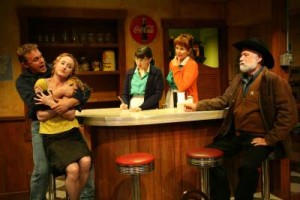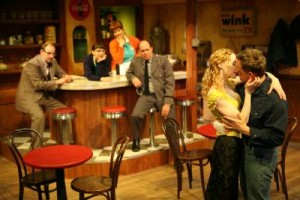
William Inge is perhaps best known for a pair of plays about life in the American
Midwest in the 1950s. Picnic tells of a frustrated small town girl who falls for a
handsome drifter. Its companion piece, Bus Stop, is about a naïve cowboy
who loses his head over a “chanteuse” with a past. Both became popular
films and gave blonde bombshells Kim Novak and Marilyn Monroe rare
chances to prove that they were actresses and not just glamour girls. Both
Picnic and Bus Stop continue to be favorites of community and regional
theaters, with the latter now getting a first-rate staging at the Rubicon in
Ventura.
Bus Stop remains a favorite with audiences because, despite being set in 1954,
its story and characters could just as easily be living somewhere in Kansas, or in
any small town, in 2008. Actors love Bus Stop because Inge created meaty
roles for them to sink their teeth into. The result, when performed by the right
cast, is “can’t miss” theater, which is the case with the current production.
In the role Kim Stanley originated, Broadway star (Thoroughly Modern Millie,
The Woman In White) Angela Christian captures all of Cherie’s sweetness and
all of her insecurities as well. With her perfect “hill folk” accent and little girl
voice, Christian wins the audience’s sympathy straight away and holds it,
even when Cherie’s stubbornness prevents her from seeing the gem of a man
right before her eyes.
Cowboy Bo, who fell head over heels for Cherie the second he saw her night
club performance and won’t take no for an answer, is brought to charming
aw-shucks life by hunky Jason Chanos. In Chanos’ talented hands, never for a
minute do we doubt Bo’s sincerity, despite moments when we cringe at his
oafish efforts to win Cherie’s love. Chanos makes Bo so genuinely pure-hearted
that we keep wanting Cherie to just open her eyes, and groan for him every
time he puts his foot in his mouth once again.
Bus Stop has been directed by Brian McDonald, himself an actor, thus it is
comes as no surprise that he has brought out the best in his perfectly cast
ensemble.
Alison Coutts-Jordan shows her versatility in the role of hard-bitten but
womanly waitress Grace, a 180 degree turn from her role as snooty society
matron Mrs. Kirby in You Can’t Take It With You. In her scenes with Lauren
Patten (as teenage waitress Elma), Coutts-Jordan reveals the kind soul behind
Grace’s tough exterior. Opposite Carl Palmer as bus driver Carl (who takes
advantage of the snow storm as an invited guest in Grace’s upstairs
bedroom), she shows us the tough-cookie waitress’s passionate side.
Teenager Patten couldn’t be better as teenage Elma, her wide-eyed
innocence and budding young womanhood seeming not for an instant to be
a performance. Palmer is equally un-actorish as a man who has probably had
a hankering for Grace for years, and delights in finally finding his way into her
bed, and perhaps even eventually into her heart. Steve Larkin, in the role of
Sheriff Will is yet another cast member who looks as if he could just have arrived
from a small town in Kansas. Larkin does memorable work as the wise and no-
nonsense Will.
One of the toughest roles in Bus Stop is that of Dr. Lyman, the English professor
with a taste for young girls of about Elma’s age. In the hands of a lesser actor,
Lyman can become nothing more than the proverbial “dirty old man,” but
Leonard Kelly Young, in a subtle and sensitive performance, shows us all his
layers. We see, and are uncomfortable seeing, the sexual deviant lurking
beneath the surface, but we also see the Shakespearean scholar, the maudlin
drunk, and the romantic with the heart of a Romeo. It is beautiful,
heartbreaking work.
Completing the cast is the outstanding John Bennett Perry as Virgil, the older
cowboy who’s been a father figure to Bo since the death of the younger
man’s parents. Perry’s Virgil seems a cross between Henry Fonda and John
Wayne, a man of few words but deep (and we begin to guess deeply hidden)
feelings, perhaps a stand-in for the playwright who kept his own homosexuality
a secret from the world.
There are many extended sequences where actors form the backdrop to
whatever scene is being played (kudos to lighting designer Thomas S.
Giamario for ever so subtly signalling where our attention should be), but a
glance in the direction of any one of them reveals an actor totally in the
moment. Theater students could learn a lot just from watching the faces of
the characters who are in the background.
Giamario also designed the set, the kind of finely detailed work that is possible
with a creative artist and a theater with enough of a budget to help him
realize his conception. A special highlight of Giamario’s design is the white
neon sign “Bus Stop/Diner” visible just above the set, which flashes on in the
darkness just before the lights go up on a scene. Another is what appears to
be actual snow falling (and melting) against the diner’s front window.
There is fine work from sound designer David Beaudry, and though Cherie’s
costumes seem a bit too contemporary, the rest of Marcy Frohlich’s designs are
perfect for the era and for the characters who wear them. Cherie’s very 2008
hairstyle is the production’s one design misstep.
There are sure to be many productions of Bus Stop across the county this year.
Fifty plus years after its Broadway premiere, it continues to be a perennial of
schools, community theaters, and larger houses. The Rubicon’s production is
one which sets the bar high for those which will follow.
Rubicon Theatre, 1006 E. Main Street, Ventura.
www.rubicontheatre.org
–Steven Stanley
February 24, 2008
Photos: Tiffany Israel, Brooks Institute of Photography




 Since 2007, Steven Stanley's StageSceneLA.com has spotlighted the best in Southern California theater via reviews, interviews, and its annual StageSceneLA Scenies.
Since 2007, Steven Stanley's StageSceneLA.com has spotlighted the best in Southern California theater via reviews, interviews, and its annual StageSceneLA Scenies.







 COPYRIGHT 2025 STEVEN STANLEY :: DESIGN BY
COPYRIGHT 2025 STEVEN STANLEY :: DESIGN BY